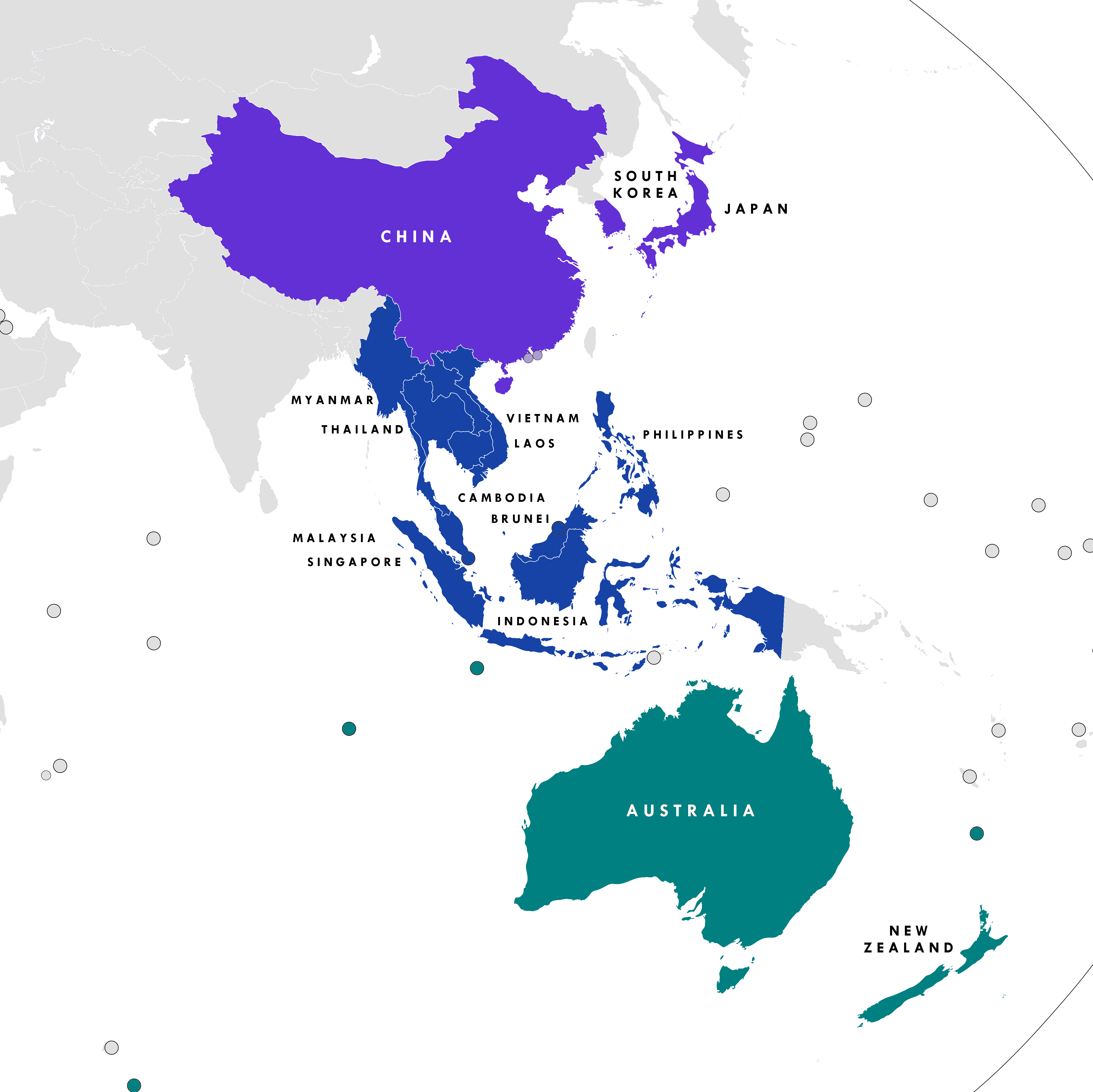Fifteen Asia-Pacific Countries Sign World’s Largest Trade Agreement
Client Alert | 15 min read | 11.16.20
Eight years after negotiations began, fifteen countries from the Asia-Pacific signed an agreement on Sunday that will create the world’s largest free trade bloc. The Regional Comprehensive Economic Partnership, or RCEP, will advance economic integration between the ten member states in the Association of Southeast Asian Nations, or ASEAN1, and Asia’s other trade powerhouses, Japan, South Korea, Australia, New Zealand and most notably, China.
The agreement will enter into force when six ASEAN Member States and three non-ASEAN participating countries ratify the agreement via their domestic procedures, which could take place as soon as two years from now. For multinational companies, RCEP’s signing and the publishing of the full text of the agreement allows for an assessment of the opportunities and risks for regional supply chains and an opportunity to review how specific provisions may affect their business in the region.

15 RCEP signatory countries: November 2020
What Does RCEP Do?
RCEP aims to boost investment and promote freer movement of goods between RCEP’s members by progressively lowering tariffs, integrating regional supply chains and countering protectionism. The deal is historic in its pure scale, with member countries contributing to approximately 30% of global Gross Domestic Product and encompassing a market of 2.1 billion people (nearly a third of the world’s population), making the RCEP the world’s largest trade pact.
The RCEP agreement comprises 20 Chapters relating to trade in goods and services, investment, temporary movement of natural persons, rules of origin, customs procedures and trade facilitation, trade remedies, intellectual property, competition, government procurement and institutional provisions. These disciplines will promote intra-regional trade between the participating countries and could incentivize the reorganization of supply chains for companies with significant operations in these markets.
Provisions on market access and common rules of origin, for example, will lower costs for manufacturers producing goods in an RCEP country, for export to another member country. This includes, of course, tariff-free or reduced-tariff treatment within the regional bloc for many goods produced in China and within ASEAN. Most notably, while most RCEP members already have existing trade agreements in place, RCEP will mark the first time that China and Japan, and Japan and South Korea, will be connected by trade agreements. Companies with manufacturing in the region will need to analyze product treatment and rules of origin within RCEP as well as in comparison to the existing regional FTA network to determine benefits for their supply chains.
In the digital space, RCEP is notable because it marks one of the first times that China has agreed to global standards on e-commerce and data flows (although the practical impact may be limited by public policy exceptions so vast they may ultimately swallow the rule, in this instance). More broadly, the agreement does not push the envelope on e-commerce and digital trade despite their rising prominence, accelerated due to COVID-19.
Enforcement of the deal is another area that will require vigilance and oversight from companies. Although a dispute settlement mechanism is present, specific Chapters are exempt until a review by RCEP members two years after the agreement enters into force.
What Does RCEP Mean for the Region?
From a geopolitical perspective, this is the second major multilateral trade agreement in the Asia-Pacific marked by the absence of the United States, following its withdrawal from the Trans-Pacific Partnership (now the CPTPP) in January 2017. Regional experts have described the RCEP deal as yet another example of China’s growing economic and commercial influence in Southeast Asia, amid a perceived retrenchment from the United States. Companies operating in the region, therefore, may find a trade landscape that is slowly aligning more with RCEP’s provisions.
The RCEP agreement is significant not just for its scope, but also its timing, coming amidst a global economic slowdown and rising populism and protectionist sentiments – as well as continued U.S.-China trade tensions. As the deal marks the first multilateral trade agreement involving Asia’s first, second and fourth-largest economies—China, Japan and South Korea—it is likely to further entrench China’s position as an economic linchpin in the region and provide the opportunity for China to further influence the region’s trade rules and trade agenda. From a wider perspective, the agreement is reflective of Asia’s positive view of multilateral trade and growing ability to set trade standards regardless of American involvement, and could facilitate the growing movement of manufacturing to markets in Southeast Asia.
India was a participant in earlier rounds of negotiations, but withdrew in 2019 over concerns that low import barriers could adversely affect vulnerable domestic industries such as agriculture, dairy and textiles. Regional observers have noted that the door remains open for the country – and its market of nearly 1.4 billion people – to rejoin the agreement in the future.
Next Steps
All multinational companies with supply chains, manufacturing bases, or key export markets based in the Asia Pacific should take note of this new deal and its provisions, which could lower costs and enable supply chain flexibility, but also increase competition from within the region. As U.S. direct investment in RCEP member countries stood at approximately USD $815 billion as of 2019, American companies invested in the region are also eligible to reap the benefits of the deal’s market access provisions and related protections.
Among other opportunities, companies should examine whether RCEP provides a basis for any of the following business impacts:
- Market Access: Reducing or eliminating tariffs on cross-border trade in goods
- Digital trade: Facilitating cross-border data flows and e-commerce
- Services: Removing regulatory barriers to trade, including for financial, telecommunications, and business services
- Intellectual Property: Providing streamlined rules for establishing intellectual property rights and improving their enforcement
- Customs: Streamlining and harmonizing customs processes, including for advance tariff classification rulings; and
- Temporary Movement of Persons: Facilitating regional travel for business employees and staff.
C&M International’s team of experienced trade policy professionals in Singapore and Washington, working alongside our international trade attorney colleagues at Crowell & Moring LLP in Washington, Los Angeles, Brussels, and Shanghai, stand ready to assist companies that would like to understand how the RCEP agreement could affect their supply chains and policy efforts, and potential opportunities to leverage it to advance their commercial and regulatory goals.
1 The Southeast Asian countries in ASEAN are Brunei, Cambodia, Indonesia, Laos, Malaysia, Myanmar, the Philippines, Singapore, Thailand and Vietnam.
Contacts
Insights
Client Alert | 5 min read | 12.12.25
Eleventh Circuit Hears Argument on False Claims Act Qui Tam Constitutionality
On the morning of December 12, 2025, the Eleventh Circuit heard argument in United States ex rel. Zafirov v. Florida Medical Associates, LLC, et al., No. 24-13581 (11th Cir. 2025). This case concerns the constitutionality of the False Claims Act (FCA) qui tam provisions and a groundbreaking September 2024 opinion in which the United States District Court for the Middle District of Florida held that the FCA’s qui tam provisions were unconstitutional under Article II. See United States ex rel. Zafirov v. Fla. Med. Assocs., LLC, 751 F. Supp. 3d 1293 (M.D. Fla. 2024). That decision, penned by District Judge Kathryn Kimball Mizelle, was the first success story for a legal theory that has been gaining steam ever since Justices Thomas, Barrett, and Kavanaugh indicated they would be willing to consider arguments about the constitutionality of the qui tam provisions in U.S. ex rel. Polansky v. Exec. Health Res., 599 U.S. 419 (2023). In her opinion, Judge Mizelle held (1) qui tam relators are officers of the U.S. who must be appointed under the Appointments Clause; and (2) historical practice treating qui tam and similar relators as less than “officers” for constitutional purposes was not enough to save the qui tam provisions from the fundamental Article II infirmity the court identified. That ruling was appealed and, after full briefing, including by the government and a bevy of amici, the litigants stepped up to the plate this morning for oral argument.
Client Alert | 8 min read | 12.11.25
Director Squires Revamps the Workings of the U.S. Patent Office
Client Alert | 8 min read | 12.10.25
Creativity You Can Use: CJEU Clarifies Copyright for Applied Art
Client Alert | 4 min read | 12.10.25
Federal Court Strikes Down Interior Order Suspending Wind Energy Development




